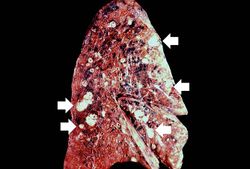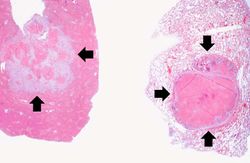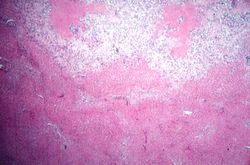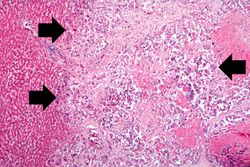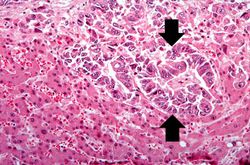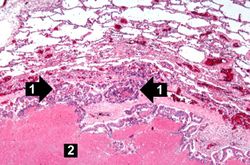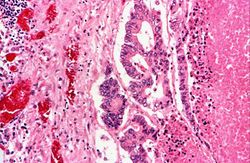Clinical Summary[edit]
This 58-year-old male was admitted five weeks earlier with a weight loss of 80 pounds over a six-month period, abdominal cramps, and rebound tenderness in the right lower quadrant. Abdominal and chest x-rays showed multiple nodular radiopacities in the lungs and liver. Fine needle biopsy of the liver revealed adenocarcinoma with the primary source thought to be colon. He was discharged on chemotherapy, but returned two days later with small bowel obstruction and sepsis, and he died a few days later.
Autopsy Findings[edit]
Autopsy revealed an obstructive firm mass in the cecum with similar masses in the lungs, lymph nodes, liver and peritoneum. A large retrocecal abscess was found. Blood cultures grew Klebsiella pneumoniae and E. coli.
This gross photograph of the liver from this case demonstrates multiple, variably-sized pale/white-tan nodules scattered throughout the liver.
This gross photograph of the lung from this case also demonstrates multiple, variably sized pale/white-tan nodules scattered throughout the lung.
These are low-power photomicrographs of a section of liver (left) and lung (right) containing tumor nodules (arrows).
This is a photomicrograph taken at the interface between the tumor (top) and the normal liver parenchyma (bottom).
This is a higher-power photomicrograph showing how the tumor cells (arrows) have infiltrated into the liver parenchyma.
This is a high-power photomicrograph of tumor cells that are forming glands (arrows).
This is a photomicrograph of a tumor nodule in the lung. The tumor cells are infiltrating into the lung parenchyma (1). There is a large area of necrosis in the center of the tumor (2).
This is a high-power photomicrograph of the edge of the tumor nodule in the lung. The tumor cells are infiltrating into the lung parenchyma (1). Even at this power you can see the glandular formation of this adenocarcinoma. There is a large area of necrosis in the center of the tumor (2).
This is a high-power photomicrograph of the edge of the tumor nodule in the lung. The tumor cells area growing in a glandular pattern. The area of necrosis is evident at the right side of the image.
Study Questions[edit]
All colorectal tumors spread by direct extension into adjacent structures and by metastasis through the lymphatics and blood vessels. In order of preference, the favored sites of metastatic spread are the regional lymph nodes, liver, lungs, and bones, followed by many other sites, including the serosal membrane of the peritoneal cavity, brain, and others. Generally the disease has spread beyond the range of curative surgery in 25 to 30% of patients.
The lesions are spread throughout both the liver and the lung and they are variably-sized. There does not appear to be a large primary tumor with multiple small "daughter tumors." Of course these only suggest metastasis. To be sure of the source of the tumor immunohistologic stains for specific diagnostic markers would be performed on the tissues to determine the tissue of origin.
Additional Resources[edit]
Reference[edit]
Journal Articles[edit]
Related IPLab Cases[edit]

